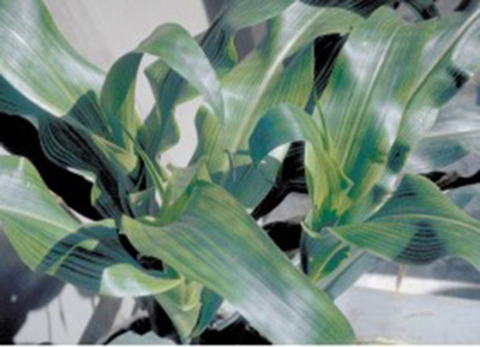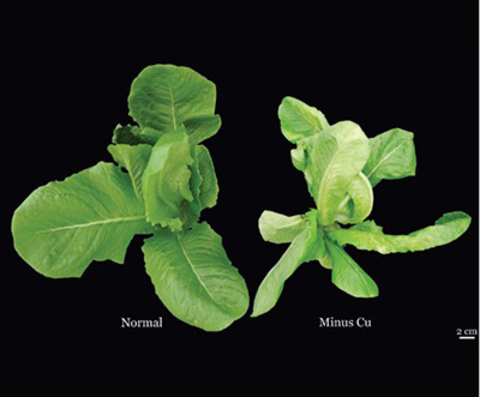What you need to know
Keep the following in mind when thinking about copper for crop production in Minnesota:
-
Use soil and plant tissue tests on organic soils to determine deficiencies and need for fertilizer.
-
Copper can be broadcast or incorporated before planting and can also be applied as a mixture with other fertilizers.
-
Copper is not recommended for mineral soils in Minnesota, due to lack of research.
Copper (Cu) is one of eight essential plant micronutrients. Copper is required for many enzymatic activities in plants and for chlorophyll and seed production. Deficiency of copper can lead to increased susceptibility to diseases like ergot, which can cause significant yield loss in small grains. Most Minnesota soils supply adequate amounts of copper for crop production. However, copper deficiency can occur in high organic matter and sandy soils.
Copper deficiency is more likely to occur in cereal grains, like wheat, barley and oat in Minnesota when grown on copper deficient soils. Some vegetable crops such as onions, lettuce and carrots are sensitive to copper deficiency.
Copper Deficiency Symptoms
The amount of copper available to plants varies widely among soils. Copper in the soil is held with clay minerals as a cation and in association with organic matter. Some silicate minerals and carbonate contain copper as impurities. Research at the University of Minnesota and other universities has identified soil conditions where a crops will respond to copper fertilizers. These conditions are:
Organic matter: Copper deficiencies often occur in soils with peaty soils and high concentrations of organic matter.
Soil texture: Sandy-textured soils are more likely to be copper deficient than loams and clays.
Soil pH: Soils that contain greater amounts of oxides and carbonates tend to have low available copper. Soils with a PH of 7.5 or greater should be monitored when crops sensitive to copper are grown.
Copper deficiency symptoms vary by crops. Copper is relatively immobile in plants and deficiency symptoms first appear in younger plant tissues.
In Minnesota, evidence of copper deficiency has appeared when small grains are grown on organic soils. Symptoms appear as a general light green to yellow color in the small grain crop. The leaf tips die back and the tips are twisted. If copper deficiency is severe, growth stops and plants die after reaching the Feekes 3.0 growth stage (tiller formation). Wheat will not produce grain in the head. In mature stands, copper deficiency can be seen in purplish brown patches, which are signs of melanosis.
In corn, deficiency first appears on new leaves as they come out of the whorl and develop a bluish green tint. New leaves may emerge from the whorl as spiraled. Necrosis may occur on older leaf-tips and edges and may die.
In vegetable crops, young leaves may turn bluish-green before turning yellow. The upper portion of the plant wilts; the growing point is stunted and eventually dies. The plants often fail to flower.
Diagnosing Copper Deficiency
Soil and plant tissue tests are recommended to determine copper deficiency in soils. Soil tests may be correlated to plant response for specific soil types.
Soil Testing: Soil tests for copper on organic soils are the best predictor of the need for copper in a fertilizer program. In Minnesota, copper status of soils can be easily measured by routine soils tests like the DTPA extraction method.
Plant Tissue Testing: A deficiency of copper can be confirmed using plant tissue analysis. Use it in conjunction with soil tests before arriving at recommendation for using copper in a fertilizer program.
Crop Response to Copper in Minnesota
Trials with hard red spring wheat grown on mineral soils have been conducted in northwestern Minnesota. Copper fertilization produced an increase in yield of hard red spring wheat only at one site. Corn response to copper has not been documented in Minnesota. Corn is only moderately sensitive to copper deficiency. Copper deficiency is rare in soybeans. Soybean response to copper has not been verified in Minnesota. Vegetable crops such as onion or carrots are more likely to respond to copper fertilizer on some soils.
Fertilizer Management
Copper sulfate is the preferred source of copper fertilizer because of low cost compared to chelated sources. Soil application of copper before seeding is most common. Copper fertilizer can be broadcast or banded with nitrogen, phosphorus, and potassium fertilizers. Copper use efficiency is improved if the fertilizer is water soluble and the particle size of the fertilizer is small. A single application of copper can last for many years. Foliar application of copper can also be an effective way to correct copper deficiency in small grains and vegetable crops.
Copper Toxicity
There is a narrow range between copper deficiency and toxicity. Take proper care during copper fertilizer application. If applied repeatedly, as well as sewage sludge and swine and dairy manure, toxicity can develop. Copper toxicity can persist for an extended period of time and is difficult to correct because of copper’s low solubility in water. Toxic concentration of copper in soil affects seed germination, root system development and plant vigor. Monitor fields that routinely receive copper fertilizers and manure.
Reviewed in 2023




